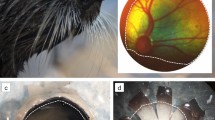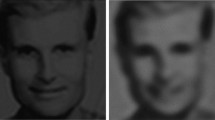Summary
Refractive states of three species of penguins (Rockhopper, Gentoo and King) were measured in air and water. Little or no refractive error, with a trend toward slight myopia (less than two dioptres), was found in air in each case. Moderate hyperopia (8–13 dioptres) exists in water. The refractive findings of this study are similar to those of a preliminary study made with the Blackfoot penguin. The relatively small alteration of refractive state associated with the change from air to water (in contrast to an approximate change of 40 dioptres for the human eye) is attributed to the flattened shape of the cornea. The chromatic aberration measured in these species is insufficient to account for the hyperopia found underwater. The maximum reduction of hyperopia resulting from a monochromatic (blue, blue-green) aquatic habitat would only amount to two dioptres. It is speculated that the remaining hyperopia is nullified by an accommodative mechanism.
Similar content being viewed by others
References
Bedford, R.E., Wyszecki, G.: Axial chromatic aberration of the human eye. J. opt. Soc. Am.47, 564–566 (1957)
Bobier, C.W., Sivak, J.G.: Chromoretinoscopy. Vision Res., in press (1977)
Duke-Elder, S.: System of ophthalmology. The eye in evolution, Vol.1. London: Henry Kimtpon 1958
Fincham, W.H.A.: Optics. London: The Hatton Press 1959
Gundlach, R.H., Chard, R.D., Skahen, R.J.: The mechanism of accommodation in pigeons. J. Comp. Psych.38, 27–42 (1945)
Johnson, G.L.: Observations on the refraction and vision of the seal's eye. Proc. Zool. Soc. (London), 714–723 (1893)
Kooyman, G.L.: Behavior and physiology of diving. In: The biology of penguins (ed. B. Stonehouse), pp. 115–137. Baltimore: University Park Press 1975
Murray, J.: Some notes by James Murray, biologist to the expedition. In: Sir Ernest Shakelton, The heart of the Antarctic, pp. 345–359. Toronto: Musson Book Co. 1910
Piggins, D.J.: Refraction of the harp seal,Pagophilus groenlandicus (Erxleben, 1777). Nature227, 78–79 (1970)
Sivak, J.G.: The role of a flat cornea in the amphibious behavior of the blackfoot penguin (Spheniscus demersus). Can. J. Zool.54, 1341–1345 (1976)
Sivak, J.G., Piggins, D.J.: Refractive state of the eye of the Polar Bear (Thalarctos maritimus Phipps). Norw. J. Zool.23, 89–91 (1975)
Sparks, J., Soper, T.: Penguins. Sydney: Angus & Robertson 1968
Walls, G.L.: The vertebrate eye and its adaptive radiation. Bloomfield Hills, Michigan: The Cranbrook Institute of Science 1942
Author information
Authors and Affiliations
Additional information
This research was supported by a grant from the National Research Council of Canada. The authors are grateful for the cooperation of the Scottish National Zoological Park, Edinburgh. In particular, the authors would like to thank Mr. Kennedy for assistance in handling the penguins. The authors would like to acknowledge the original observation by Barbara Sivak concerning the flattened appearance of the penguin cornea.
Rights and permissions
About this article
Cite this article
Sivak, J.G., Millodot, M. Optical performance of the penguin eye in air and water. J. Comp. Physiol. 119, 241–247 (1977). https://doi.org/10.1007/BF00656636
Received:
Issue Date:
DOI: https://doi.org/10.1007/BF00656636




